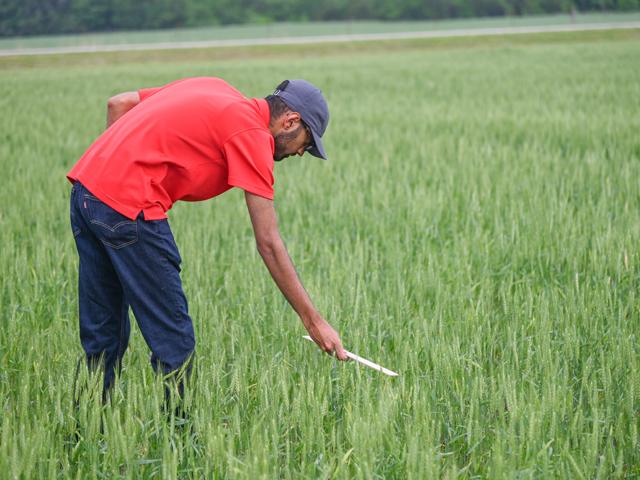Hard Winter Wheat Tour Final Results
Hard Winter Wheat Tour Final Average Yield Estimate: 39.7 BPA
MANHATTAN, Kan. (DTN) -- The Wheat Quality Council's 2022 Hard Winter Wheat Tour ended May 19 where it started in Manhattan, Kansas, with a total weighted average yield estimate of 39.7 bushels per acre (bpa). It's slightly higher than the USDA projection for the state at 39 bpa.
However, more than 80 tour participants predicted total production for Kansas -- the nation's top wheat-producing state -- will be lower than the USDA forecast. The tour's estimate is 261 million bushels compared to 271 million by the government, which collected information for its initial assessment of the crop at the beginning of May.
Kansas Wheat CEO Justin Gilpin said more wheat fields than normal could be abandoned. Kansas planted 7.4 million acres of winter wheat, and the USDA expects about 6% won't be harvested. If the tour production estimate is right -- tour officials said it is usually close to final yield figures – abandonment would be about 10 to 11% or a 10 million-bushel difference.
"The crop scouts, because of the drought and heat stress and poor wheat in western Kansas, believe there will be high-than-average abandonment (which is about 6%)," Gilpin said. Many fields contained sparse stands and plenty of exposed, powdery dirt. Some wheat would be too short to combine and other fields sustained hail damage, which could be zeroed out by crop insurance adjusters.
Spotty and variable stands were themes during the tour, due to months of dry weather and recent extreme heat. Although some central and eastern Kansas fields recorded better-projected yields (some over 80 bpa), the 2022 wheat crop is expected to fall short of last year's 362 million bushel crop, which yielded 52 bpa.
The tour made 550 stops, assessing production potential and plant health. The vast majority of fields sampled were in Kansas, though a few were in the southernmost counties of Nebraska and the northernmost counties of Oklahoma.
The May 19 samples came from a shortened route from Wichita to Manhattan. Forty-eight stops were made with a weighted yield average of 55.2 bpa.
A bright spot of the tour was little disease or insect pressure was reported by scouts.
P[L1] D[0x0] M[300x250] OOP[F] ADUNIT[] T[]
Romulo Lollato, Kansas State University Extension wheat specialist, said the biggest surprise of the tour was the harsh growing conditions that southwest Kansas producers experienced this year extended eastward and to the south-central part of the state more than expected.
"Even though the drought wasn't as severe to the east, soils are sandier that can't hold as much water," Lollato said. "A positive is less wheat streak mosaic was found."
For most of the tour's 40-plus-year history, it was held at the beginning of May. Organizers shifted it last year to the third week of May to allow more participants to get COVID-19 vaccinations.
Wheat industry officials said the current timeframe will be maintained since it gives wheat users and growers a more accurate assessment of production that can aid in future wheat buying and marketing decisions.
"The industry already knew the situation in the Southern Plains. The tour gave more verification about the stress conditions the crop is under, especially in southwest Kansas," Gilpin said.
Jackson Allen, a grain merchandiser with Gavilon in Wichita, said lower wheat yields usually mean protein levels improve, which is good for end-users. He's not overly worried the company won't be able to ship enough wheat to meet customer needs.
"It's a little concerning for us [that]there's a smaller (Kansas) wheat crop, but we have a big draw area," Allen said. "We'll just buy as much wheat as we can after harvest starts like every year."
For more on the wheat tour:
-- Wheat Tour Day 2: https://www.dtnpf.com/…
-- Wheat Tour Day 1: https://www.dtnpf.com/…
Videos:
-- Interview with Gilpin about Day 3 of the wheat tour: https://www.dtnpf.com/…
-- Interview with Aaron Harries, vice president of research and operations with Kansas Wheat, about estimated yield results and more observations from Day 2 of the tour: https://www.dtnpf.com/…
-- Interview with Gilpin about Day 1 of the wheat tour: https://www.dtnpf.com/…
Matthew Wilde can be reached at matt.wilde@dtn.com
Follow him on Twitter @progressivwilde
(c) Copyright 2022 DTN, LLC. All rights reserved.






